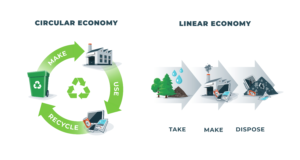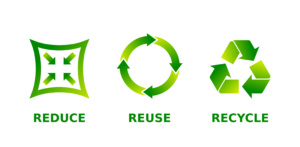Circularity, in the form of re-use, is not really new as a business model. Look at Goodwill, Habitat For Humanity’s Re-Store, and countless local consignment and thrift stores. eBay, Etsy, and Facebook Marketplace provide an online forum to convert one person’s trash to someone else’s treasure. A quick trip to the post office and the deal is sealed. Waste averted.
This is a good start for sure, but how do we take this to scale? What happens when participants are not individuals, but businesses – large businesses? What if I’m not looking for a glass vase, but 20 desks for my new startup company? What if I want to build a house out of reclaimed materials? What if I’m a hospital that is shutting down or getting renovated? New companies like Rheaply and Recapturit are providing the platform to connect the dots when the dots are many. Those 20 desks are out there, but they are scattered around the country. And those 20 desks may not all be available at the same time that I need them. Suddenly a thoughtful distribution network becomes critical.
These emerging re-use hubs will make huge advances in the circular economy by matching a vast array of products and materials to new users, thereby keeping them out of the landfill. There is SO much potential for the re-use market, but we have to be careful to see to its growth with the same sustainable mindset that got us this far, and that includes distribution.
One group of researchers in Finland found that renting clothing is worse than throwing it away, mainly because of the added transportation involved. Does it have to be this way? Should we abandon the second-hand market? Of course not. But we do need to be transparent and address all externalities and related impacts. We need to relocate these materials in a way that will not undo the good of preempting new manufacturing in a potentially globe-traversing linear supply chain.
Distribution planning is something supply chain planners do every day. We got this. Let’s use it. Arkieva knows all about lean logistics & transportation and network design. As with all markets, there are two levels to distribution planning:
- Design the network. This includes deciding how many depots to build and where to use them. It includes defining which routes to consider for various modes of transportation. Using an optimization model to do this allows you to not only determine the best configuration for today, but also provides a tool that you can use as volumes grow, decline, and otherwise shift. It’s extremely important to have a tool that allows you to respond to an ever-changing environment. If the last two years haven’t proved that to you, then nothing will!
- Develop a tactical plan. Here you can manage more detailed requirements that become relevant in the short term. This includes things like truck-loading, storage capabilities at the warehouses, lead times, and which transportation mode to use for specific shipments. Optimization models work beautifully here too to balance supply and demand while considering all costs and trade-offs.
And because we are in the circular mindset, we must choose our performance metrics and objectives carefully. Is it all about reducing costs? Not necessarily. Yes, cost minimization is important, if we include all relevant costs – storage, shipping, labor, energy, etc. But let’s also track and gauge GHG emissions. Let’s track waste and shrinkage. Let’s use a triple bottom line.
One great thing about transitioning to circular supply chains is that we do not have to start from scratch. We are already doing a lot of the right things; we just need to do more of it. And in many cases, we need to shift our mindset.
- Lots of companies re-use materials now because it saves money. We need to re-use more. By shifting our mindset, we’ll see that we can save more money with circularity, in the form of more control and less disruptions.
- We use technology today to manage supply chains – a lot of Excel, but a lot of more sophisticated tools, too. We need to use technology more. We must manage and understand our supply chains as one integrated system and not through piece-meal silo-style systems. Sure, machine learning (ML) and artificial intelligence (AI) are the buzzwords of today, and they are great, but good old optimization models are far from being used to their potential. Let’s not throw away a perfectly good tool because something newer and shinier is stealing the spotlight.
- Today’s planning tools track and minimize costs. We need to track more. We need to track waste, emissions, social well-being (of our employees and society as a whole). Having consistent metrics and the right tool will yield a balanced, realistic, win-win solution.
As supply chain planners, we have the skills and the understanding of how to make circular supply chains work. We know all about optimizing a distribution network. To go circular in the area of re-use and the secondhand economy and to take it to scale, let’s use what we know and apply some good old-fashioned network planning to this new paradigm.







